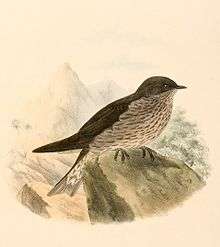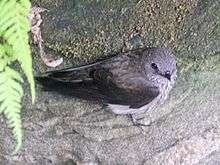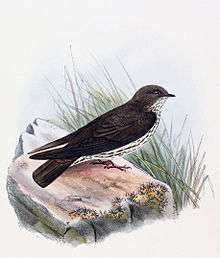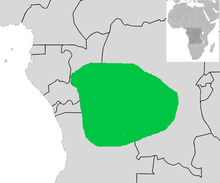Phedina
Phedina is a small genus of passerine birds in the swallow family. It has two members, the Mascarene martin, Phedina borbonica, which has two subspecies in Madagascar and the Mascarene Islands respectively, and Brazza's martin, P. brazzae, which breeds in the Democratic Republic of the Congo (DRC), the Republic of the Congo, and northern Angola. The nearest relative of the Phedina martins is the banded martin, Riparia cincta, which resembles Brazza's martin in nesting habits and vocalisations. Both Phedina martins have grey-brown upperparts and paler, heavily streaked underparts. Adult Mascarene martins are 15 cm (5.9 in) in length, and Brazza's martin is smaller at 12 cm (4.7 in) long. Both species have brown wings, dark brown eyes and a black bill and legs. Juvenile birds have more diffuse breast streaking and pale edges to the feathers of the back and wings than the adults. Both species can be distinguished from most other swallows in their breeding or wintering ranges by the streaking on the underparts and lack of a deeply forked tail. The Mascarene martin has a warbled siri-liri siri-liri song given in flight, but Brazza's martin has quite different vocalisations, its song consisting of a series of short notes followed by a complex buzz and sometimes some final clicks.
| Phedina | |
|---|---|
 | |
| Mascarene martin, (Phedina borbonica) | |
| Scientific classification | |
| Kingdom: | Animalia |
| Phylum: | Chordata |
| Class: | Aves |
| Order: | Passeriformes |
| Family: | Hirundinidae |
| Subfamily: | Hirundininae |
| Genus: | Phedina Bonaparte, 1855 |
Both species typically breed in small groups: the Mascarene martin builds a shallow cup nest of twigs and coarse plant material with a soft inner lining, whereas Brazza's martin makes a small heap of soft material such as feathers or dry grass at the end of a typically 50-cm (20-in) tunnel in a riverbank. The normal clutch is three eggs for Brazza's martin, two for Mascarene martins on Madagascar and Mauritius, and two or three for those on Réunion. As with other swallows, both martins feed on flying insects, hunting in single-species groups or with other swallows and swifts.
Brazza's martin may be hunted by humans, and both species may be infected with a variety of parasites. These swallows may be affected by poor weather when breeding, but neither appears to be under serious threat. The small islands which are the home of the Mascarene martin subspecies P. b. borbonica may be devastated by cyclones, which have the potential to cause severe temporary losses to the populations on Mauritius and Réunion. The legal protection afforded to the Phedina martins varies with jurisdiction, and ranges from none for Mascarene martins on Réunion to special protection for the same species on Madagascar. The Brazza's martin is not a protected species anywhere in its range.
Taxonomy
The French biologist Charles Lucien Bonaparte created the genus Phedina in 1855 to accommodate the Mascarene martin, previously Hirundo borbonica, which he considered to be sufficiently different from other Hirundo species to merit its own genus.[1] The only other member of the genus is the Brazza's martin, P. brazzae, first described by French zoologist Émile Oustalet in 1886. The genus name is derived from the Greek phaios (φαιός) "brown" and the Italian rondine "swallow".[2] The species name for the Mascarene martin refers to the Île de Bourbon (Réunion),[3][4] and that for Brazza's martin commemorates Italian-born French explorer Pierre Savorgnan de Brazza, later to become governor-general of the French Congo,[5] who collected the type specimen.[6]
The Phedina species are members of the swallow family of birds, and are classed as members of the Hirundininae subfamily, which comprises all swallows and martins except the very distinctive river martins. DNA sequence studies suggest that there are three major groupings within the Hirundininae, broadly correlating with the type of nest built. These groups are the "core martins", including burrowing species like the sand martin; the "nest-adopters", which are birds like the tree swallow that utilise natural cavities; and the "mud nest builders", such as the barn swallow, which build a nest from mud. Based on the DNA analysis, the Phedina species are placed in the "core martins".[7][8]
The genus Phedina is thought to be an early offshoot from the main swallow lineage, although their striped plumage suggests a distant relationship with several streaked African Hirundo species.[9][10] In the past it has sometimes been suggested that Brazza's martin should be moved to its own genus Phedinopsis due to the significant differences in vocalisations and nest type from its relative.[9][11] The nearest relative of the Phedina martins is the banded martin, Riparia cincta, which appears not to be closely related to the other members of its current genus and resembles Brazza's martin in nesting habits and vocalisations.[7][12] The current Association of European Rarities Committees (AERC)-recommended practice is to move the banded martin to its own genus as Neophedina cincta, rather than to merge it into Phedina, since the banded martin's larger size, different bill and nostril shape and non-colonial nesting are differences from the other Phedina species.[13]
Species
| Image | Scientific name | Common name | Distribution |
|---|---|---|---|
 | Phedina borbonica | Mascarene martin | Madagascar and in the Mascarene Islands. |
| Phedina brazzae | Brazza's martin | Angola, the Republic of the Congo, and the Democratic Republic of the Congo | |
Description

Both Phedina martins have grey-brown upperparts and paler, heavily streaked underparts. Adult Mascarene martins of the nominate subspecies are 15 cm (5.9 in) long with wings averaging 116.6 mm (4.59 in)[14] and weigh 23.9 g (0.84 oz).[15] The tail is slightly forked and the wings are blackish-brown.[14] The Madagascan subspecies is overall paler and larger-billed than the nominate form. It has denser streaking on the breast, but only very fine lines on the lower abdomen and on the white undertail. It is distinctly smaller than the nominate subspecies, 12–14 cm (4.7–5.5 in)[16] in length with an average weight of 20.6 g (0.73 oz).[15] The Brazza's martin is 12 cm (4.7 in) long with dark brown wings averaging 100.5 mm (3.96 in). It has a brownish tint to the breast plumage and a square tail. Both species have dark brown eyes and a black bill and legs. Juvenile birds have more diffuse breast streaking, and white tips or buff edges to the feathers of the back and wings.[14][17][18]
Both species can be distinguished from most other swallows in their breeding or wintering ranges by the streaking on the underparts.[17] Although the lesser striped swallow has white underparts with dark streaking, it is larger, has a deeply forked tail and a very different plumage, with dark blue upperparts, a red rump and a chestnut head.[19]
The vocalisations of the two martins are quite different. Mascarene martin has a warbled siri-liri siri-liri song given in flight or when perched;[14] some calls given by perched birds end in a glissando.[20] Other vocalisations may be used during mating or displays of aggression. There is a chip contact call,[14] and the young birds produce a fast twittering sound when begging for food.[20] Birds wintering in mainland Africa are usually silent.[16] The song of Brazza's martin consists of a series of short notes increasing in frequency which are followed by a complex buzz and sometimes completed by a number of clicks. The song becomes increasingly loud, although the final clicks are quite soft. The song is similar to that of the banded martin, and does not resemble that of the Mascarene martin, suggesting unresolved taxonomic problems.[12]
The flight of both species is heavy, with slow wingbeats interspersed with glides.[17][21][22]
Distribution and habitat


Both species occur in sub-Saharan Africa. The Mascarene martin's breeding range is restricted to Madagascar and the Mascarene Islands. The nominate subspecies breeds on Mauritius and Réunion and P. b. madagascariensis occurs in Madagascar. It may also nest on Pemba where it has been seen in the breeding season. Breeding habitat can be anywhere with suitable sites for constructing a nest, such as ledges, buildings, tunnels, caves or amongst rocks. The martin is found on the east side of Réunion between 200–500 m (660–1,640 ft), and on the south and west coasts of Mauritius. It also occurs on inland cliffs on Mauritius.[14] P. b. borbonica is resident on Mauritius and Réunion, although there are local seasonal movements on these island, but the Madagascan subspecies is migratory, with the martins moving to lower ground or to the African mainland outside the breeding season.[14] It is normally uncommon and local in coastal Mozambique,[16] Zambia, Malawi and Pemba Island,[23] and very rare in Kenya and mainland Tanzania,[24][25] although large numbers sometimes winter in Mozambique or Malawi. It has also been recorded from Comoros and other Indian Ocean locations including at least four islands in the Seychelles.[26][27] Some of these records may be due to vagrant birds carried by cyclones.[14] There are unsubstantiated claims of occurrences in the Transvaal.[28]
The distribution of the Brazza's martin was initially poorly studied,[29] although it is now known to breed in the south of the Democratic Republic of the Congo (DRC), the Republic of the Congo, and in northern Angola. There is one probable sighting from southeast Gabon.[22] In the breeding season this martin is found near rivers with the steep banks that are needed for the nest burrows. Suitable habitat occurs along lowland tropical rivers like the Congo[17] or rivers with sandbanks in the highlands of Angola. The highland locations have wide grassy riverways running through miombo woodlands,[12] whereas the Congo Basin is tropical forest with over 200 cm (79 in) of rain a year. The lowland habitats are a patchwork of dry, seasonally flooded and permanently wet woodland, and seasonally flooded savanna.[30] This martin seems to be able to adapt to open savanna habitats containing Hymenocardia acida, in which it will roost overnight when not breeding, and is therefore not heavily dependent on the neighbouring forests as long as the riverine breeding sites survive.[12]
Behaviour
Breeding
The Mascarene martin nests in the wet season, August to November in Madagascar, and September to early January on Mauritius and Réunion. Brazza's martin breeds from July to October. Both species typically breed in small groups, but their nesting habits are quite different. The Mascarene martin builds a shallow cup nest of twigs and coarse plant material such as grass and Casuarina with a softer lining of feathers and finer vegetation. It may be constructed anywhere suitably flat and inaccessible to predators, including locations 3–5 m (9.8–16.4 ft) over water, on slate ledges, or in underground passageways, whereas Brazza's martin makes a small heap of soft material such as feathers or dry grass at the end of a typically 50-cm (20-in) tunnel in a riverbank. The normal clutch is three eggs for Brazza's martin, two for Mascarene martins on Madagascar and Mauritius, but two or three for those on Réunion.[14][17]
The Mascarene martin eggs are white with brown spots and average 21.6 mm × 15 mm (0.85 in × 0.59 in) with a weight of 2.5 g (0.088 oz) and are incubated by the female alone. The white eggs of Brazza's martin measure 18.5 mm × 112.5 mm (0.73 in × 4.43 in) and weigh 1.5 g (0.053 oz). The incubation and fledging times are unknown for both species,[14][17] although as with all hirundines the chicks are altricial, hatching naked and blind.[31]
Feeding
As with other swallows, both martins feed on flying insects, hunting in single-species groups or with other swallows and swifts. They feed low over a variety of open habitats or woodland.[12][14][22][32] Prey items recorded for the Mascarene martin include scarab, click and other beetles, Hemiptera and flying ants,[33] and Brazza's martins will take termites.[17] In eastern Africa, areas deforested by logging or conversion to agriculture are used for hunting by Brazza's martins.[14][34]
Predators and parasites
No predators or parasites are recorded for Brazza's martin, but Mascarene martins will mob the Mauritius kestrel, suggesting that it is perceived as a potential predator.[35] Mascarene martins may host a variety of parasites. On Mauritius they may be infected by an endemic trypanosome, Trypanosoma phedinae,[36] although the pathogenicity is unknown.[37] Protozoan blood parasites of the genus Haemoproteus have also been found in the Mascarene martin on Mauritius,[38] although no blood parasites were found in a Madagascan specimen.[39] A new species of louse fly, Ornithomya cecropis, was first found on a martin in Madagascar,[40] and another bird from that island carried the feather mite Mesalges hirsutus, more commonly found in parrots.[41][42]
Status
Until 2008 the Brazza's martin was classified as Data Deficient because there had been so little ornithological research in this part of Africa,[32] but a 2007 paper presented evidence that extended its known range by 500 km (310 mi) to the north and 175 km (109 mi) southwards, a quadrupling of the area.[12] It has a large range of 402,000 km2 (155,000 sq mi) although the total population is unknown. Its extensive range and apparently stable population means this bird is classed as Least Concern on the IUCN Red List.[43] It is likely that this species is dug out for food by humans, but its small, dispersed colonies in firm soil suggests that it is a less rewarding target than the densely packed sandbank nests of species such as the African river martin and rosy bee-eater.[12]
The breeding range of the Mascarene martin is restricted to three islands. Madagascar has an area of 592,800 km2 (228,900 sq mi),[44] but the next largest island, Réunion, is just 2,512 km2 (790 km2).[45] Although this bird has a limited range, it is abundant on Mauritius and Réunion, and locally common in Madagascar. The population is unknown, but exceeds the vulnerability threshold of 10,000 mature individuals and is believed to be stable. This martin is therefore also classed as a species of Least Concern by the International Union for Conservation of Nature.[46]
Both species may be affected by poor weather. Breeding colonies of Brazza's martins in river sandbars are liable to flooding,[32] but this does not appear to be having a serious impact, and this species appears to be under no immediate threat. Its ability to use degraded habitats also aids its survival.[43] Tropical cyclones present a threat to the Mascarene martin, particularly on the small islands inhabited by the nominate subspecies. The populations on Mauritius and Réunion were badly affected by a six-day cyclone in February 1861, taking many years to recover,[47] but by about 1900 it was reported to be common but local, and in 1973–74 there were 200–400 pairs on Réunion and 70–75 pairs in Mauritius. More recent cyclones, like one in 1980, seem to have had less damaging effects than the 1861 storm.[14] Several species have been lost from the Mascarene islands since human colonisation in the seventeenth century, but the martin and the Mascarene swiftlet occur on all the main islands, and are less vulnerable to the effects of human activities, especially since they can utilise houses for nest sites.[48]
The Brazza's martin is not a protected species in Angola,[49] the DRC,[50] or the Republic of Congo.[51] In Mauritius, the Mascarene martin is legally protected as a "Species of wildlife in respect of which more severe penalties are provided",[52] although Madagascar and the African mainland countries have no special measures for this species beyond general bird protection legislation.[53] Réunion is an overseas department of France, but the Birds Directive does not apply outside Europe, so there is no bird protection legislation effective on the island, despite the possibility that EU agricultural and other funding may be adversely affecting birds and vulnerable habitats.[48][54]
References
- Bonaparte, Charles Lucien (1855). "Note sur les Salanganes et sur les nids". Comptes Rendus Hebdomadaires des Séances de l'Académie des Sciences (in French). 41: 976–979.
- Jobling (2010) p. 302.
- Jobling (2010) p. 74.
- Gmelin (1789) p. 1017.
- Jobling (2010) p. 76.
- Sharpe & Wyatt (1894) p. 207.
- Sheldon, Frederick H; Whittingham, Linda A; Moyle, Robert G; Slikas, Beth; Winkler, David W (2005). "Phylogeny of swallows (Aves: Hirundinidae) estimated from nuclear and mitochondrial DNA". Molecular Phylogenetics and Evolution. 35 (1): 254–270. doi:10.1016/j.ympev.2004.11.008. PMID 15737595.
- Winkler, David W; Sheldon, Frederick H (1993). "Evolution of nest construction in swallows (Hirundinidae): A molecular phylogenetic perspective" (PDF). Proceedings of the National Academy of Sciences USA. 90 (12): 5705–5707. doi:10.1073/pnas.90.12.5705. PMC 46790. PMID 8516319. Archived from the original (PDF) on 2011-07-17. Retrieved 2012-12-14.
- Turner & Rose (1989) p. 8.
- Turner & Rose (1989) pp. 70–72.
- Wolters, Hans Edmund (1971). "Probleme der Gattungsabgrenzung in der Ornithologie" (PDF). Bonner Zoologische Beitraege (in German). 22 (3–4): 210–219.
- Mills, Michael S L; Cohen, Callan (2007). "Brazza's Martin Phedina brazzae: new information on range and vocalisations". Ostrich. 78 (1): 51–54. doi:10.2989/OSTRICH.2007.78.1.8.52.
- Crochet et al. (2011) p. 4.
- Turner & Rose (1989) pp. 155–157.
- Dunning (2007) p. 327.
- Sinclair et al (2002) p. 298.
- Turner & Rose (1989) p. 157.
- Turner & Rose (1989) pp. 58–59.
- Turner & Rose (1989) pp. 194–197.
- Diamond (1987) p. 110.
- Langrand (1991) p. 254.
- King, Tony (2007). "Brazza's Martin Phedina brazzae in the Lesio-Louna Reserve, Congo Republic" (PDF). Malimbus. 29 (1): 46–49.
- Williams & Arlott (1980) p. 260.
- Zimmerman et al (2005) p. 427.
- Stevenson et al (2004) p. 290.
- Skerrett, Adrian; Betts, Michael; Bullock, Ian; Fisher, David; Gerlach, Ron; Lucking, Rob; Phillips, John; Scott, Bob (2006). "Third report of the Seychelles Bird Records Committee" (PDF). Bulletin of the African Bird Club. 13 (1): 65–72.
- "March 2012". Seychelles Bird Records Committee. Archived from the original on 16 December 2012. Retrieved 16 December 2012.
- Tarburton (1987) pp. 4, 176.
- Chapin, James Paul (1953). "The Birds of the Belgian Congo: Part 3". Bulletin of the American Museum of Natural History. 75A: 742–743.
- World Wildlife Fund; Sigsgaard, Lene; McGinley, Mark "Eastern Congolian swamp forests" in Cleveland, Cutler J (ed.) (2006) Encyclopedia of Earth Environmental Information Coalition, National Council for Science and the Environment. Retrieved 4 November 2012.
- Turner & Rose (1989) p. 4.
- BirdLife International (2012). "Phedina brazzae". IUCN Red List of Threatened Species. 2012. Retrieved 16 July 2012.CS1 maint: ref=harv (link)
- Goodman, Steven M; Parrillo, Phillip (1997). "A study of Malagasy birds based on stomach contents". Ostrich. 68: 104–113. doi:10.1080/00306525.1997.9639723.
- Clancey, P A; Lawson, Walter J; Irwin, Michael P Stuart (1969). "The Mascarene Martin Phedina borbonica (Gmelin) in Mozambique: a new species to the South African list". Ostrich. 40 (1): 5–8. doi:10.1080/00306525.1969.9634318.
- Diamond (1987) p. 229.
- Peirce, M A; Cheke, A S; Cheke, R A (1977). "A survey of blood parasites of birds in the Mascarene Islands, Indian Ocean: with descriptions of two new species and taxonomic discussion". Ibis. 119 (4): 451–461. doi:10.1111/j.1474-919X.1977.tb02053.x.
- Diamond (1987) pp. 171–172.
- Peirce, M A; Mead, C J (1976). "Haematozoa of British birds. I. Blood parasites of birds from Dumfries and Lincolnshire". Bulletin of the British Ornithologists' Club. 96 (4): 128–132.
- Bennetti, Gordon F; Blancoul, J (1974). "A note on the blood parasites of some birds from the Republic of Madagascar" (PDF). Journal of Wildlife Diseases. 10 (3): 239–240. doi:10.7589/0090-3558-10.3.239. PMID 4210766.
- Hutson, A M (1971). "New species of the Ornithomya biloba-group and records of other Hippoboscidae (Diptera) from Africa". Journal of Entomology Series B, Taxonomy. 40 (2): 139–148. doi:10.1111/j.1365-3113.1971.tb00116.x.
- Gaut, Jean (1952). "Sarcoptides plumicoles des oiseaux de Madagascar". Mémoires de l'Institut scientifique de Madagascar: Biologie animale (in French). 7: 81–107.
- Schöne, Richard; Schmidt, Volker; Sachse, Margit; Schmöschke, Ronald (2009). "Federmilben bei Papageienvögeln" (PDF). Papageien (in German). 22 (2): 55–61.
- "Species factsheet Phedina brazzae". BirdLife International. Retrieved 5 December 2012.
- Bureau of African Affairs (3 May 2011). "Background Note: Madagascar". US Department of State. Retrieved 24 August 2011.
- Petit & Prudent (2010) pp. 84–87.
- BirdLife International (2012). "Phedina borbonica". IUCN Red List of Threatened Species. 2012. Retrieved 16 July 2012.CS1 maint: ref=harv (link)
- Sharpe, Richard Bowdler (1870). "On the Hirundinidae of the Ethiopian Region". Proceedings of the Zoological Society: 286–321. (from 295).
- Maggs (2009) p. 10–12.
- de Klemm & Lausche (1986) pp. 262–266.
- de Klemm & Lausche (1986) pp. 515–518.
- "Protected Species in Republic of Congo". Projet d'appui à l'Application de la Loi sur la Faune sauvage. Retrieved 3 November 2012.
- "Wildlife and National Parks Act 1993". Government of Mauritius. Archived from the original on 14 November 2010. Retrieved 15 December 2012.
- de Klemm & Lausche (1986) pp. 357–360, 369–375, 488.
- Papazoglou et al (2004) p. 23.
Cited texts
- Crochet, P-A; Barthel, P-AP H; Bauer, H-G; van den Berg, A B; Bezzel, E; Collinson, J M; Dietzen, C; Dubois, P J; Fromholtz, J; Helbig, A J; Jiguet, F; Jirle, E; Knox, A G; Krüger, T; Le Maréchal, P; van Loon, A J; Päckert, M; Parkin, D T; Pons, J-M; Raty, L; Roselaar, C S; Sangster, G; Steinheimer, F D; Svensson, L; Tyrberg, T; Votier, S C; Yésou, P (2011). AERC TAC's taxonomic recommendations: 2011 report (PDF). Luxembourg: AERC.
- Diamond, Anthony William (1987). Studies of Mascarene Island Birds. Cambridge: Cambridge University Press. ISBN 0-521-25808-1.
- Dunning, John Barnard (2007). CRC Handbook of Avian Body Masses (Second ed.). Boca Raton: CRC Press. ISBN 978-1-4200-6444-5.
- Gmelin, Johann Friedrich (1789). Caroli a Linné systema naturae per regna tria naturae, secundum classes, ordines, genera, species, cum characteribus, differentiis, synonymis, locis. Editio decima tertia, aucta, reformata. Tomus I. Pars II (in Latin). Lipsiae [Leipzig]: Beer.
- Jobling, James A (2010). The Helm Dictionary of Scientific Bird Names (PDF). London: Christopher Helm. ISBN 978-1-4081-2501-4.
- de Klemm, Cyrille; Lausche, Barbara J (1986). African Wildlife Laws (IUCN Environmental Policy & Law Occasional Paper; No. 3). Seiburg: World Conservation Union. ISBN 2-88032-091-7.
- Langrand, Olivier (1991). Guide to the Birds of Madagascar. New Haven: Yale University Press. ISBN 0-300-04310-4.
- Maggs, Gwen; Ladkoo, Amanda; Poongavanan, Sandra; Chowrimootoo, Aurélie; Tucker, Rachel; Mangroo, Walter; Dawson, Kimberly; Cole, Julie; Baross, Sally; Morris, Anne; Whitfield, Harriet (2009). Olive White-Eye Recovery Program Annual Report 2008–09. Vacoas: Mauritian Wildlife Foundation.
- Papazoglou, Clairie; Kreiser, Konstantin; Waliczky, Zoltán; Burfield, Ian (2004). Birds in the European Union: a status assessment (PDF). Wageningen: BirdLife International. ISBN 0-946888-56-6.
- Petit, Jérôme; Prudent, Guillaume, eds. (2010). Climate Change and Biodiversity in the European Union Overseas Entities (PDF). Gland & Brussels: International Union for Conservation of Nature. ISBN 978-2-8317-1315-1.
- Sinclair, Ian; Hockey, Phil; Tarboton, Warwick (2002). SASOL Birds of Southern Africa. Cape Town: Struik. ISBN 1-86872-721-1.
- Sinclair, Ian; Langrand, Olivier (2004). Birds of the Indian Ocean Islands: Madagascar, Mauritius, Réunion, Rodrigues, Seychelles and the Comoros. Cape Town: Struik. ISBN 1-86872-956-7.
- Stevenson, Terry; Fanshawe, John; Small, Brian; Gale, John; Arlott, Norman (2004). Birds of East Africa: Kenya, Tanzania, Uganda, Rwanda, Burundi. London: Christopher Helm. ISBN 0-7136-7347-8.
- Tarburton, Warwick (1987). Birds of the Transvaal. Pretoria: Transvaal Museum. ISBN 0-620-10006-0.
- Turner, Angela K; Rose, Chris (1989). A Handbook to the Swallows and Martins of the World. London: Christopher Helm. ISBN 0-7470-3202-5.
- Williams, John; Arlott, Norman (1980). A Field Guide to the Birds of East Africa. London: Collins. ISBN 0-00-219179-2.
- Zimmerman, Dale A; Pearson, David J; Turner, Donald A (2005). Birds of Kenya and Northern Tanzania. London: Christopher Helm. ISBN 0-7136-7550-0.